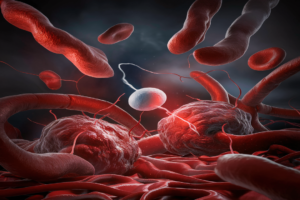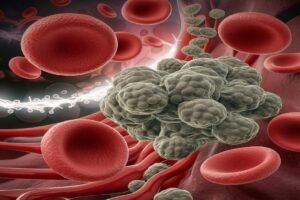Blood Cancer
Introduction
In our state of the art time of state of the art clinical science, blood sickness continues to be a monumental adversary in the area of prosperity and wellbeing. This convoluted assembling of afflictions, portrayed by the weird improvement of platelets, presents gigantic hardships concerning end, treatment, and the chiefs.
In this organized examination, we intend to give a total cognizance of blood illness, wrapping its various types, secondary effects, illustrative systems, and treatment modalities.
Types of Blood Cancer
Leukemia
Leukemia, one of the fundamental kinds of blood threatening development, shows up as the uncontrolled extension of peculiar white platelets. Beginning in the bone marrow, leukemia disturbs the body’s ability to convey sound platelets, provoking different aftereffects and disarrays.
This sort of blood threatening development is moreover organized into extreme and progressing structures, each with its own exceptional characteristics and treatment moves close.
Lymphoma
Lymphoma, another immense characterization of blood threatening development, impacts the lymphatic system, which expects an essential part in safe capacity. This infection rises out of unusual lymphocytes, a sort of white platelet, and can show up as Hodgkin lymphoma or non-Hodgkin lymphoma.
Lymphoma habitually gives the improvement of developments in lymph centers, spleen, or other lymphoid tissues, joined by an extent of secondary effects depending upon the subtype and period of the disorder.
Myeloma
Myeloma, generally called different myeloma, basically impacts plasma cells, which are responsible for making antibodies to fight defilements. In this kind of blood illness, hazardous plasma cells gather in the bone marrow, debilitating normal platelet creation and making hurt bone tissue.
Myeloma gives a specific game plan of incidental effects, including bone distress, inadequacy, vulnerability to infections, and disarrays associated with kidney capacity.
Symptoms of Blood Cancer
General Side effects
Blood malignant growth frequently gives various vague side effects that can be demonstrative of other ailments too. A few general side effects include:
Tenacious weakness
Unexplained weight reduction
Fever and night sweats
Continuous diseases
Simple swelling or dying
Shortcoming and torpidity
Explicit Side effects
The side effects of blood malignant growth might shift relying upon the kind and phase of the sickness. For example:
Leukemia:
Patients might encounter side effects like simple swelling, exorbitant dying, successive nosebleeds, enlarged lymph hubs, and exhaustion.
Lymphoma:
Side effects might incorporate enlarged lymph hubs, fever, unexplained weight reduction, constant weakness, and tingling.
Myeloma:
Patients might give side effects like bone agony, particularly toward the back or ribs, shortcoming, continuous diseases, and side effects connected with kidney brokenness, like expanded thirst and pee.

Diagnosis of Blood Cancer
Laboratory Tests
Diagnosing blood sickness much of the time begins with a cautious evaluation of a patient’s clinical history and secondary effects, followed by a movement of exploration focus tests.
These tests could consolidate absolute blood count (CBC), blood smear, and periphery circulation system cytometry to overview the presence of uncommon platelets and their properties.
Imaging Studies
Imaging studies, similar to X-radiates, figured tomography (CT) analyzes, alluring resonation imaging (X-beam), and positron outpouring tomography (PET) channels, may be performed to survey the level of the sickness, perceive developments or oddities in the lymph center points, bones, or organs, and choose the period of the illness.
Bone Marrow Biopsy
A bone marrow biopsy incorporates the extraction of a little illustration of bone marrow tissue for minute evaluation and assessment.
This technique confirms the presence of disastrous cells in the bone marrow and gives significant information about the sort, subtype, and reality of blood dangerous development.
Treatment Options for Blood Cancer
Chemotherapy
Chemotherapy remains a groundwork of blood sickness treatment, including the usage of extreme prescriptions to demolish dangerous development cells or block their turn of events.
This fundamental therapy may be controlled orally, intravenously, or directly into the cerebrospinal fluid, dependent upon the sort and period of the infection.
Immunotherapy
Immunotherapy tends to a significant method for managing dangerous development treatment, handling the power of the body’s protected system to see and dispense with sickness cells.
This innovative treatment could incorporate the usage of monoclonal antibodies, safe assigned spot inhibitors, or open cell move, offering new assumption for patients with blood infection who have not addressed standard drugs.
Assigned Treatment
Assigned treatment bases on unambiguous sub-nuclear targets or pathways related with the turn of events and perseverance of sickness cells, thusly restricting mischief to sound tissues.
This exactness based approach has improved the treatment of blood sickness, with drugs zeroing in on unambiguous genetic changes or unusual hailing pathways showing striking sufficiency and less negative effects.
Undifferentiated cell Transplantation
Fundamental microorganism transplantation, generally called hematopoietic undifferentiated cell transplantation (HSCT) or bone marrow transplantation, incorporates the implantation of strong youthful microorganisms into the patient’s circulatory framework to displace hurt or contaminated bone marrow.
This philosophy thinks about the recuperation of common platelet creation and may be used as a medicinal treatment decision for explicit kinds of blood illness, particularly leukemia, lymphoma, and myeloma.

Conclusion
All things considered, blood threatening development remains an impressive test in the space of oncology, impacting countless individuals in general and introducing basic clinical and accommodating complexities.
By sorting out the various sorts, incidental effects, logical techniques, and treatment decisions for blood harmful development, patients, gatekeepers, and clinical consideration specialists can coordinate to investigate the complexities of this affliction and attempt towards additional created results and worked on private fulfillment for those influenced by blood sickness.
FAQs about Blood Cancer
- What causes blood cancer?
- Can blood cancer be prevented?
- How is blood cancer diagnosed?
- What are the risk factors for developing blood cancer?
- Are there support groups available for individuals with blood cancer?
Note:-
The information provided on this blog regarding medicnn price and side effects is solely based on data collected from public domains. I am not a doctor or a medical professional. While i strive to provide accurate and up to date information, I cannot guarantee the absolute accuracy or completeness of the data. It is always recommended to consultee with a qualified healthcare professional or doctor for personalized medical advice and information . the content on this blog should not be considered a substitute for professional provided at their own discretion and risk . I do not assume any responsibility for any consequences arising from the use of the information on this blog . Thank you
